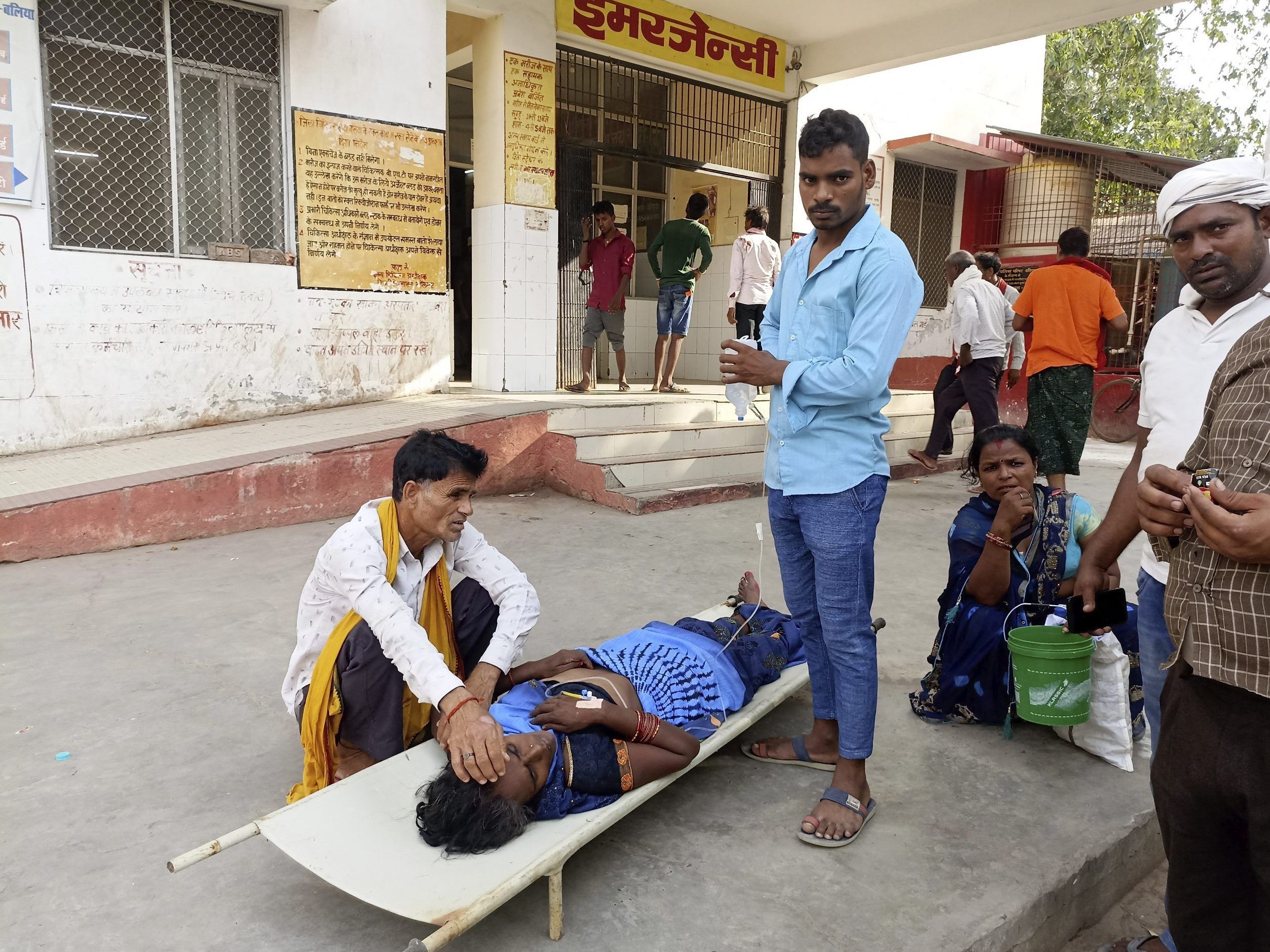Don’t head for the hills , you might get ticked off .Ontario tracks spread of tick-borne illnesses as top doc links it climate change
Author of the article:Canadian Press
Published Jul 02, 2023 • Last updated 1 day ago • 2 minute read
Ontario’s top doctor expects to see a growing number of cases of tick-borne illness in the province, in addition to Lyme disease.
Ontario’s top doctor expects to see a growing number of cases of tick-borne illness in the province, in addition to Lyme disease. PHOTO BY ISTOCK /GETTY IMAGES
TORONTO — Ontario’s top doctor expects to see a growing number of cases of three types of tick-borne illness in the province, in addition to Lyme disease — a spread he says is directly linked to climate change.
A new regulation that takes effect this weekend requires health-care providers in Ontario to report cases of anaplasmosis, babesiosis and Powassan virus to their local medical officers of health.
There have been anecdotal reports and publications about the three illnesses being found in Ontario in recent years, but the province now needs to start formally tracking them, said Chief Medical Officer of Health Dr. Kieran Moore.
“We can now count and track when these illnesses are occurring, map it for a risk map and be able to inform the public when these diseases become more prevalent,” he said in an interview.
“It’s absolutely expected that we’ll have greater incidence over the next several years because this is a known wave of infections that we’ve seen migrate up the coastline of northeast North America and anticipate them affecting Ontarians.”
Over the last 20 years, there has been a rise in the incidence of Lyme disease as ticks, particularly black-legged ticks, are able to survive the winters, Moore said. The United States has seen waves of anaplasmosis, babesiosis and Powassan virus come after cases of Lyme disease, Moore said, and he expects to see that in Ontario as well.
“It is simply from the ability of these ticks, that are now able to survive our winters and stay and breed over their two-year lifecycle,” Moore said.
“We’ve seen them migrate from the mid-eastern United States and now that wave of migration we’ve seen go through Connecticut and New York and these diseases are following in the footsteps of Lyme disease and we anticipate that we’ll have more cases of these.”
Anaplasmosis is caused by bacteria that gets into a person’s bloodstream through a tick bite. It causes fever and chills, but can also suppress bone marrow and the creation of white and red blood cells, as well as platelets, Moore said.
Babesiosis, on the other hand, presents similarly to malaria, he said. Ticks transmit intracellular parasites, which get inside a person’s red blood cells and burst them, so people can present with anemia, along with having fever and chills.
Most infections of Powassan virus are asymptomatic, but people might have fever, headache, nausea, vomiting, weakness, or aches and pains. But after an acute phase and a period of remission, an infected person may experience confusion, loss of co-ordination, difficulty speaking, paralysis, seizures or coma, said Associate Chief Medical Officer of Health Dr. Michelle Murti.
“Approximately 50% of people who survive severe disease have long-term health problems, such as recurring headaches, loss of muscle mass and strength, and memory problems,” she said.
There is no specific treatment for Powassan virus disease, according to the Centers for Disease Control in the United States, rather patients’ symptoms are managed. Anaplasmosis and babesiosis can be treated with antibiotics for symptomatic cases.
To prevent tick bites, people spending time outdoors are advised to use insect repellent and wear permethrin-treated clothing, then do a daily tick check. Anyone who has found a tick attached to them should see a doctor if they get a fever within the next month, Moore said.
View attachment 18639

Ontario tracks spread of tick-borne illnesses as top doc links it climate change
Ontario’s top doctor expects to see a growing number of cases of tick-borne illness in the province, in addition to Lyme disease.torontosun.com
It's Climate Change I tell'ya!! IT'S CLIMATE CHANGE!!
- Thread starter B00Mer
- Start date
You are using an out of date browser. It may not display this or other websites correctly.
You should upgrade or use an alternative browser.
You should upgrade or use an alternative browser.
A carbon tax would have prevented this.Nearly 100 die as India struggles with a sweltering heatwave in 2 most populous states
Author of the article:Associated Press
Associated Press
Biswajeet Banerjee
Published Jun 18, 2023 • Last updated 2 days ago • 3 minute read
LUCKNOW, India — At least 96 people died in two of India’s most populous states over the last several days, officials said Sunday, with swaths of the country reeling from a sweltering heatwave.
The deaths happened in the northern state of Uttar Pradesh and eastern Bihar where authorities warned residents over 60 and others suffering various maladies to stay indoors during the daytime.
All the fatalities in Uttar Pradesh, totaling 54, were reported in Ballia district, some 300 kilometres southeast of Lucknow, the state capital. Authorities found out most of those who passed away were over 60 years old and had preexisting health conditions, which may have been exacerbated by the intense heat.
S. K. Yadav, a medical officer in Ballia, said in the past three days, some 300 patients were admitted to the district hospital for various ailments aggravated by heat.
Due to the gravity of the situation, authorities canceled leave applications of medical personnel in Ballia and provided additional hospital beds in the emergency ward to accommodate the influx of patients.
Officials said most of the admitted patients are aged 60 and above, exhibiting symptoms of high fever, vomiting, diarrhea, breathing difficulties and heart-related issues.
R.S. Pathak, a resident of Ballia who lost his father on Saturday, said that he witnessed an increased flow of patients at the hospital’s emergency ward while attending to his father.
“This has never happened in Ballia. I have never seen people dying because of the heat in such large numbers,” he said. “People fear venturing out. The roads and markets are largely deserted.”
Ballia, along with central and eastern Uttar Pradesh, is currently grappling with oppressive heat.
On Sunday, the district experienced a maximum temperature of 43 degrees Celsius, surpassing the normal range by five degrees. The relative humidity was recorded at 25%, intensifying the effect of the heat.
Atul Kumar Singh, a scientist from the India Meteorological Department, or IMD, said temperatures across the state were presently above normal. He added, “no relief is expected in the next 24 hours.”
The IMD issued an alert saying heatwave conditions would last until June 19 in parts of Uttar Pradesh.
The state’s health minister, Brijesh Pathak, said that they have opened an investigation into the cause of death of “so many people” in Ballia.
In eastern Bihar, scorching heat has engulfed most of the state, leading to 42 deaths in the past two days. Among the fatalities, 35 occurred at two hospitals in the state capital of Patna where over 200 patients suffering from diarrhea and vomiting were being treated.
Patna recorded a maximum temperature of 44.7 degrees Celsius on Saturday.
The main summer months — April, May and June — are generally the hottest in most of India, before monsoon rains bring in cooler temperatures.
But temperatures have become more intense in the past decade. During heat waves, the country usually suffers severe water shortages, with tens of millions of its 1.4 billion people lacking running water.
A study by World Weather Attribution, an academic group that examines the source of extreme heat, found that a searing heat wave in April that struck parts of South Asia was made at least 30 times more likely by climate change.
In April, the heat caused the death of 13 people at a government event in India’s financial capital of Mumbai and prompted some states to close all schools for a week.
— Associated Press writer Indrajit Singh in Patna, India contributed to this story.

Nearly 100 die as India struggles with a sweltering heatwave in 2 most populous states
At least 96 people died in two of India's most populous states over the last several days, officials said Sunday.torontosun.com
Or it might not but let's freak everyone out anyway.expects to see a growing number of cases of tick-borne illness in the province
35C in th shade here todayLucky you. It's not that comfortable out east.
There have always been ticks or mites of some sort or another, not necessarily related to climate change. But hey, he's a "doctor" and "anecdotal reports" are scientific (apparently).Ontario tracks spread of tick-borne illnesses as top doc links it climate change
Author of the article:Canadian Press
Published Jul 02, 2023 • Last updated 1 day ago • 2 minute read
Ontario’s top doctor expects to see a growing number of cases of tick-borne illness in the province, in addition to Lyme disease.
Ontario’s top doctor expects to see a growing number of cases of tick-borne illness in the province, in addition to Lyme disease. PHOTO BY ISTOCK /GETTY IMAGES
TORONTO — Ontario’s top doctor expects to see a growing number of cases of three types of tick-borne illness in the province, in addition to Lyme disease — a spread he says is directly linked to climate change.
A new regulation that takes effect this weekend requires health-care providers in Ontario to report cases of anaplasmosis, babesiosis and Powassan virus to their local medical officers of health.
There have been anecdotal reports and publications about the three illnesses being found in Ontario in recent years, but the province now needs to start formally tracking them, said Chief Medical Officer of Health Dr. Kieran Moore.
“We can now count and track when these illnesses are occurring, map it for a risk map and be able to inform the public when these diseases become more prevalent,” he said in an interview.
“It’s absolutely expected that we’ll have greater incidence over the next several years because this is a known wave of infections that we’ve seen migrate up the coastline of northeast North America and anticipate them affecting Ontarians.”
Over the last 20 years, there has been a rise in the incidence of Lyme disease as ticks, particularly black-legged ticks, are able to survive the winters, Moore said. The United States has seen waves of anaplasmosis, babesiosis and Powassan virus come after cases of Lyme disease, Moore said, and he expects to see that in Ontario as well.
“It is simply from the ability of these ticks, that are now able to survive our winters and stay and breed over their two-year lifecycle,” Moore said.
“We’ve seen them migrate from the mid-eastern United States and now that wave of migration we’ve seen go through Connecticut and New York and these diseases are following in the footsteps of Lyme disease and we anticipate that we’ll have more cases of these.”
Anaplasmosis is caused by bacteria that gets into a person’s bloodstream through a tick bite. It causes fever and chills, but can also suppress bone marrow and the creation of white and red blood cells, as well as platelets, Moore said.
Babesiosis, on the other hand, presents similarly to malaria, he said. Ticks transmit intracellular parasites, which get inside a person’s red blood cells and burst them, so people can present with anemia, along with having fever and chills.
Most infections of Powassan virus are asymptomatic, but people might have fever, headache, nausea, vomiting, weakness, or aches and pains. But after an acute phase and a period of remission, an infected person may experience confusion, loss of co-ordination, difficulty speaking, paralysis, seizures or coma, said Associate Chief Medical Officer of Health Dr. Michelle Murti.
“Approximately 50% of people who survive severe disease have long-term health problems, such as recurring headaches, loss of muscle mass and strength, and memory problems,” she said.
There is no specific treatment for Powassan virus disease, according to the Centers for Disease Control in the United States, rather patients’ symptoms are managed. Anaplasmosis and babesiosis can be treated with antibiotics for symptomatic cases.
To prevent tick bites, people spending time outdoors are advised to use insect repellent and wear permethrin-treated clothing, then do a daily tick check. Anyone who has found a tick attached to them should see a doctor if they get a fever within the next month, Moore said.
View attachment 18639

Ontario tracks spread of tick-borne illnesses as top doc links it climate change
Ontario’s top doctor expects to see a growing number of cases of tick-borne illness in the province, in addition to Lyme disease.torontosun.com
Anecdotal reports are only scientific if they agree with the dogma.There have always been ticks or mites of some sort or another, not necessarily related to climate change. But hey, he's a "doctor" and "anecdotal reports" are scientific (apparently).
Ahh, of course. Silly me!Anecdotal reports are only scientific if they agree with the dogma.
Smokin hot alright. Only half listening to globull news this am, and they were yapping about someplace in BC having the hottest day since 1957. Who knew we had globull warming in the 50s?World registers hottest day ever recorded on Monday
Scientists say to expect more records to fall this year as climate change and an emerging El Nino pattern make the mercury climb.
View attachment 18652
You shush. It was supposed to stay cold.Smokin hot alright. Only half listening to globull news this am, and they were yapping about someplace in BC having the hottest day since 1957. Who knew we had globull warming in the 50s?




